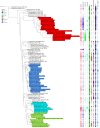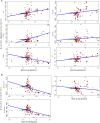Driven progressive evolution of genome sequence complexity in Cyanobacteria
- PMID: 33149190
- PMCID: PMC7643063
- DOI: 10.1038/s41598-020-76014-4
Driven progressive evolution of genome sequence complexity in Cyanobacteria
Abstract
Progressive evolution, or the tendency towards increasing complexity, is a controversial issue in biology, which resolution entails a proper measurement of complexity. Genomes are the best entities to address this challenge, as they encode the historical information of a species' biotic and environmental interactions. As a case study, we have measured genome sequence complexity in the ancient phylum Cyanobacteria. To arrive at an appropriate measure of genome sequence complexity, we have chosen metrics that do not decipher biological functionality but that show strong phylogenetic signal. Using a ridge regression of those metrics against root-to-tip distance, we detected positive trends towards higher complexity in three of them. Lastly, we applied three standard tests to detect if progressive evolution is passive or driven-the minimum, ancestor-descendant, and sub-clade tests. These results provide evidence for driven progressive evolution at the genome-level in the phylum Cyanobacteria.
Conflict of interest statement
The authors declare no competing interests.
Figures




References
-
- Moya A. The Calculus of Life. New York: Springer; 2014.
-
- Gould SJ. Full House: The Spread of Excellence from Plato to Darwin. New York: Harmony Books; 1996.
-
- McShea DW, Brandon RN. Biology’s First Law. Chicago: Chicago University Press; 2010.

